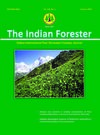In Vitro Propagation of Withania somnifera L. (Dunal) from Callus of Embryonic Cotyledon Explants in B5 Medium
DOI:
https://doi.org/10.36808/if/2018/v144i1/121304Keywords:
India, Bio-Diversity, Environmental Condition, Reproductive Biology, Medicinal, Anti-Tumor, Secondary Metabolites.Abstract
Withania somnifera (Solanaceae) has extensive medicinal properties and one of its products is commonly called as asgand. Pharmacological properties of Withania somnifera are diverse ranging from anti-inflammatory, anti-tumor, anti-stress, anti-oxidant, immunomodulatory, hemopoetic and cardio-protective effects. In the past twenty years in vitro tissue culture technology has been successfully used in commercial settings to produce disease free plants, mass propagation and to conserve and protect endangered plants. This in vitro tissue culture technique is now being used globally for the multiplication of medicinally important plant species and also responsible to produces large numbers of secondary metabolites.References
Ahmad M., Saleem S., Ahmad A.S., Ansari M.A., Yusuf S., Hoda M.M. and Islam F. (2005). Neuroprotective effect of Withania somnifera on 6hydroxydopamine indused Parkinsonism in rat. Hum. Exp. Toxicol., 24(3):137-147.
Bhattacharya A., Ghosal S. and Bhattacharya S.K. (2001). Antioxidant effect of Withania somnifera glycowithanolides in chronic foodshok stress induced perturbation of oxidative free radical scavenging enzymes and lipid peroxidation in rat frontal cortex and striatum. J. Ethanopharmacol., 74(1):1-6.
Bhattacharya S.K., Satyan K.S. and Ghosal S. (1997). Antioxidant activity of glycowithanolides from Withania somnifera. Indian J. Exp. Biol., 35(3):236-9.
Chatterjee A. and Pakrashi S.C. (1995). The Treatise on Indian Medicinal Plants, 4:208-212.
Chaturvedi H.C., Madhu J. and Kidwai N.R. (2007). Cloning of medicinal plants thourgh tissue culture–A review. Indian J. Experimental Biology, 45:937-948
Davis L. and Kuttan G. (2002). Effect of Withania somnifera on cell mediated immune responses in mice. J. Exp. Clin. Cancer Res., 21(4):585590.
Garg P., Pankaj K. and Divay G. (2011). Plant tissue culture of Jatropha curcas L.: A REVIEW. Imperial J. Pharmaceutics and Cosmetology, 1(1):6-13.
Kaur K., Rani G., Widodo N., Nagpal A., Taira K., Kaul S.C. and Wadhwa R. (2004). Evaluation of the anti-proliferative and anti-oxidative activities of leaf extract from in vivo and in vitro raised Ashwagandha. Food and Chemical Toxicol., 42(12):2015-2020.
Nagashayana N., Sankarankutty P., Nampoothiri M.R., Mohan P.K. and Mohan K.P. (2000). Association of M Dopa with recovery following Ayurveda medication in Parkinson disease. J. Neurol. Sci., 176(2):124-127.
Owk A.K., Geddam J. and Sape S.T. (2011). In vitro plant regeneration from leaf explants of Withania somnifera (L) Dunal (Ashwaganda) - an important medicinal plant Research. Biotechnology, 2(5): 34-39.
Panda S. and Kar A. (1997). “Evidence for free radical scavenging activity of Ashwagandha root powder in mice. Ind. J. Physiol. Pharmacol., 41(4):424-426.
Rege N.N., Thatte U.M. and Dahanukar S.A. (1999). Adaptogenic activity of six rasayana herbs used in Ayurvedic medicine. Phytotherapy. Res., 13(4):275-291.
Scartezzini P. and Speroni E. (2000). Review on some plants of Indian traditional medicine with antioxidant activity. J. Ethnopharmacol., 71(1-2): 23–43.
Singh N., Agarwal A.K., Lata A. and Kohli R.P. (1977). Experimental evaluation of ‘adaptogenic’ properties of Withania somnifera. In: Proceeding of the XIIth Scientific Seminar on Indian Medicine, Institute of Medical Sciences. Varanasi. 4 pp.
Singh N., Verma P., Pandey B.R. and Gilca M. (2011). Role of Withania somnifera in prevention and treatment of cancer: An overview. Inter. J. Pharma. Sci. and Drug Rese., 3(4):274-279.
Singh N., Singh S.P., Sinha J.N., Shanker K. and Kohli R.P. (1982). Withania somnifera (Ashwagandha) A rejuvenator herbal drug which enhances survival during stress (An adaptogen). Int. J. Crude Res., 3:29-35.
Singh S.P., Singh D.R., Gupta M.L., Singh N. and Kohli R.P. (1979). An experimental evaluation of anti tumor activity of Withania somnifera (Ashwagandha) and “Geriforte†Proc. XI Annual Conf. of Ind. Pharmacol. Sos., 11(1):65.
Singh B., Saxena, A.K., Chandan B.K., Gupta D.K., Bhutani K.K. and Anand K.K. (2001). Adoptagenic activity of novel withanolide free aqueous fraction from the roots of Withania somnifera. Phytother. Res., 15:311–318.
Singh N., Agarwal A.K., Lata A. and Kohli R.P. (1976). Evaluation of Adaptogenic properties of Withania somnifera. Proc. Ind. Pharmacol. Soc., pp.21.
Sussex I.M. (2008). The scientific roots of modern plant biotechnology. Plant Cell, 20(5):1189–1198.
Yadav B., Bajaj A., Saxena M. and Saxena A.K. (2010). In vitro anticancer activity of the root, stem and leaves of Withania somnifera against various human cancer cell lines. Indian J. Pharm. Sci., 72(5):659-663.
Downloads
Downloads
Published
How to Cite
Issue
Section
License
Unless otherwise stated, copyright or similar rights in all materials presented on the site, including graphical images, are owned by Indian Forester.





